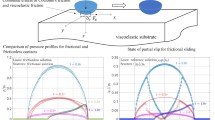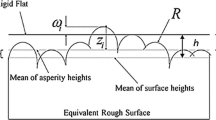Abstract
Dynamic frictional slip along an interface between plastically compressible solids is analyzed. The plane strain, small deformation initial/boundary value problem formulation and the numerical method are identical to those in Shi et al. (Int J Fract 162:51, 2010) except that here the material constitutive relation allows for plastic compressibility. The interface is characterized by a rate and state dependent friction law. The specimens have an initial compressive stress and are subject to shear loading by edge impact near the interface. Two loading conditions are analyzed, one giving rise to a crack-like mode of slip propagation and the other to a pulse-like mode of slip propagation. In both cases, the initial compressive stress is taken to vary with plastic compressibility such that the associated initial effective stress is the same for all values of plastic compressibility. The volume change for the crack-like slip mode is mainly plastic while the elastic volume change plays a larger role for the pulse-like mode. For the crack-like slip mode, the proportion of plastic dissipation in the material increases with the increasing plastic compressibility, but the effect of plastic compressibility on the energy partitioning for the pulse-like slip mode is much smaller. The predicted propagation speeds approach a speed about the dilational wave speed for both the crack-like and pulse-like slip modes and this speed is not sensitive to the value of the plastic compressibility parameter. Plastic dissipation is found to be mainly associated with the deformation induced by the loading wave rather than with the deformation arising from slip propagation. The amplitude of the slip rate in the slip pulses is found to be largely governed by the value of the initial compressive stress regardless of the value of plastic compressibility.















Similar content being viewed by others
References
Adams GG (1995) Self-excited oscillations of two elastic half-spaces sliding with a constant coefficient of friction. J Appl Mech 62:867–872
Andrews DJ, Ben-Zion Y (1997) Wrinkle-like slip pulse on a fault between different materials. J Geophys Res 102:553–571
Bar-Sinai Y, Aldam M, Spatschek R, Brener EA, Bouchbinder E (2019) Spatiotemporal Dynamics of frictional systems: the interplay of interfacial friction and bulk elasticity. Lubricants 7:91
Beeler NM, Tullis TE (1996) Self-healing slip pulses in dynamic rupture models due to velocity dependent strength. Bull Seismol Soc Am 86:1130–1148
Belytschko T, Chiapetta RL, Bartel HD (1976) Efficient large scale non-linear transient analysis by finite elements. Int J Numer Meth Eng. 10:579–596
Ben-Zion Y, Huang Y (2002) Dynamic rupture on an interface between a compliant fault zone layer and a stiffer surrounding solid. J Geophys Res 107:2042
Bouchbinder E, Brener EA, Barel I, Urbakh M (2011) Slow cracklike dynamics at the onset of frictional sliding. Phys Rev Lett 107:235501
Cochard A, Rice JR (2000) Fault rupture between dissimilar materials: ill-posedness, regularization, and slip-pulse response. J Geophys Res 105:25891–25907
Coker D, Lykotrafitis G, Needleman A, Rosakis AJ (2005) Frictional sliding modes along an interface between identical elastic plates subject to shear impact loading. J Mech Phys Solids 53:884–992
Deshpande VS, Fleck NA (2000) Isotropic constitutive models for metallic foams. J Mech Phys Solids 48:1253–1283
Dieterich JH (1979) Modeling of rock friction. 1 Experimental results and constitutive equations. J Geophys Res 84:2161–2168
Dunham EM, Bhat HS (2008) Attenuation of radiated ground motion and stresses from three-dimensional supershear ruptures. J Geophys Res 113:B08319
Heaton TH (1990) Evidence for and implications of self-healing pulses of slip in earthquake rupture. Phys Earth Planet Int 64:1–20
Hutchens SB, Needleman A, Greer JR (2011) Analysis of uniaxial compression of vertically aligned carbon nanotubes. J Mech Phys Solids 59:2227–2237
Krieg RO, Key SW (1973) Transient shell response by numerical time integration. Int J Numer Meth Eng 7:273–286
Kurzon I, Lyakhovsky V, Ben-Zion Y (2019) Dynamic rupture and seismic radiation in a damage-breakage rheology model. Pure Appl Geophys 176:1003–1020
Linker MF, Dieterich JH (1992) Effects of variable normal stress on rock friction: observations and constitutive equations. J Geophys Res 97:4923–4940
Lu X, Lapusta N, Rosakis AJ (2007) Pulse-like and crack-like ruptures in experiments mimicking crustal earthquakes. Proc Natl Acad Sci USA 104:18931–18936
Lu X, Lapusta N, Rosakis AJ (2010) Pulse-like and crack-like dynamic shear ruptures on frictional interfaces: experimental evidence, numerical modeling, and implications. Int J Fract 163:27–39
Lykotrafitis G, Rosakis AJ (2006) Dynamic sliding of frictionally held bimaterial interfaces subjected to impact shear loading. Proc R Soc A 462:2997–3026
Needleman A (2018) Dynamic mode II crack growth along an interface between an elastic solid and a plastic solid. J Mech Phys Solids 120:22–35
Passelègue FX, Schubnel A, Nielsen S, Bhat HS, Madariaga R (2013) From sub-Rayleigh to supershear ruptures during stick-slip experiments on crustal rocks. Science 340:1208–1211
Peirce D, Shih CF, Needleman A (1984) A tangent modulus method for rate dependent solids. Comput Struct 18:875–887
Povirk GL, Needleman A (1993) Finite element simulations of fiber pull-out. J Eng Mater Tech 115:286–291
Prakash V (1998) Frictional response of sliding interfaces subjected to time varying normal pressures. J Tribol 120:97–102
Prakash V, Clifton RJ (1993) Pressure-shear plate impact measurement of dynamic friction for high speed machining applications. In: Proceedings of the 7th International Congress on Exp. Mech., Society of Experimental Mechanics, Bethel, pp. 556–564
Ranjith K, Rice JR (2001) Slip dynamics at an interface between dissimilar materials. J Mech Phys Solids 49:341–361
Renardy M (1992) Ill-posedness at the boundary for elastic solids sliding under Coulomb friction. J. Elasticity 27:281–287
Rice JR, Ruina AL (1983) Stability of frictional sliding. J Appl Mech 50:343–349
Rosakis AJ, Xia K, Lykotrafitis G, Kanamori H (2007) Dynamic shear rupture in frictional interfaces: speeds, directionality, and modes. In: Schubert G (ed) Treatise on Geophysics, Elsevier, 153–192
Ruina AL (1983) Slip instability and state variable friction laws. J Geophys Res 88:10359–10370
Shi Z, Ben-Zion Y, Needleman A (2008) Properties of dynamic rupture and energy partition in a solid with a frictional interface. J Mech Phys Solids 56:5–24
Shi Z, Needleman A, Ben-Zion Y (2010) Frictional slip modes and partition of energy during dynamical frictional sliding between identical elastic-viscoplastic solids. Int J Fract 162:51–67
Shlomai H, Fineberg J (2016) The structure of slip-pulses and supershear ruptures driving slip in bimaterial friction. Nat Commun 7:11787
Taj W, Coker D (2018) Dynamic frictional sliding modes between two homogenous interfaces. IOP Conf Ser 295, 012001
Templeton EI, Baudet A, Bhat HS, Dmowska R, Rice JR, Rosakis AJ, Rousseau C-E (2009) Finite element simulations of dynamic shear rupture experiments and dynamic path selection along kinked and branched faults. J Geophys Res 114:B08304
Xu S, Ben-Zion Y (2013) Numerical and theoretical analyses of in-plane dynamic rupture on a frictional interface and off-fault yielding patterns at different scales. Geophys J Int 193:304–320
Zheng G, Rice JR (1998) Conditions under which velocity-weakening friction allows a self-healing versus a crack-like mode of rupture. Bull Seismol Soc Am 88:1466–1483
Author information
Authors and Affiliations
Corresponding author
Additional information
Publisher's Note
Springer Nature remains neutral with regard to jurisdictional claims in published maps and institutional affiliations.
Rights and permissions
About this article
Cite this article
Needleman, A. Dynamic frictional slip along an interface between plastically compressible solids. Int J Fract 230, 179–191 (2021). https://doi.org/10.1007/s10704-021-00551-w
Received:
Accepted:
Published:
Issue Date:
DOI: https://doi.org/10.1007/s10704-021-00551-w




